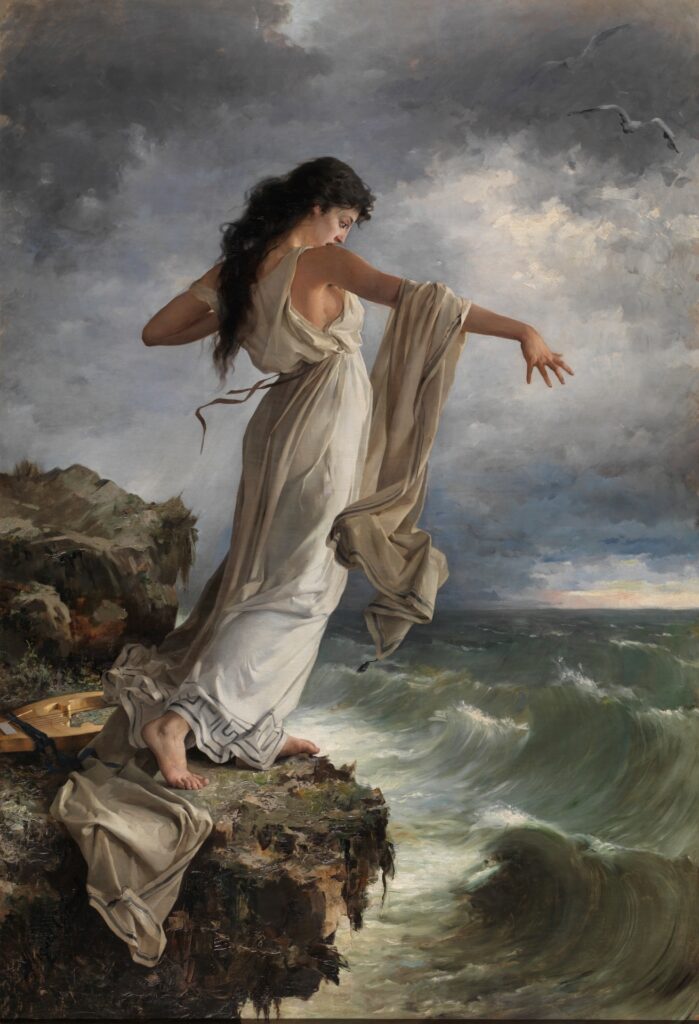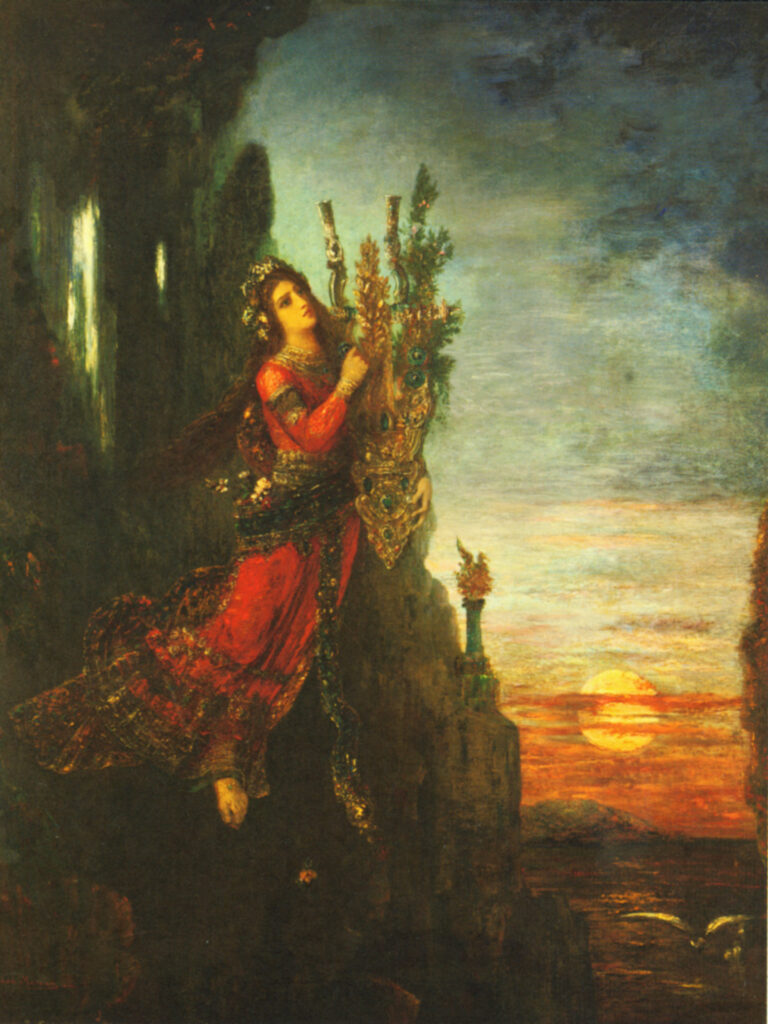2020.09.04 | By Gregory Nagy
§0. In a painting that goes by the title Safo, by Miguel Carbonel Selva, dated 1880, we see the figure of Sappho at the moment when she is about to leap to her death, plunging into the sea from the heights of Leukas. Her death is timed to happen at sunset, and the timing is the same in other renditions as well. A most striking additional example is a painting by Gustave Moreau, dated around 1893. But I ask this question: why sunset?

CARBONELL SELVA, MIGUEL
Image via Museo Nacional del Prado

§1. The story about the fatal leap of Sappho into the sea at a headland named Leukas, which means ‘White Rock’, is best known today from a version that we read in a collection of elegiac poems by Ovid about female heroes, the Heroides. This version is Heroides 15, which fictionalizes a plaintive letter written by a lovesick Sappho before she takes her fatal leap. Her letter is addressed to a beautiful young male lover named Phaon, whom she tearfully reproaches for having abandoned her and having voyaged off to parts West. Although the attribution of Heroides 15 to Ovid has been questioned (Tarrant 1981), the artistry of this poem has been much admired—and it merits being described as Ovidian (Peponi 2018, with extensive bibliography).
§2. In any case, I concentrate here not on the artistic merits of Heroides 15 but rather on the mass of learned references that the poet is making to the poetics of Sappho. In my work on the songs of Sappho, I have found these references to be a most valuable source of information in my efforts to reconstruct the original wording of Sappho’s songs, the textual transmission of which is lamentably fragmentary (a case in point is analyzed in Nagy 2015 §129).
§3. The text of Heroides 15 is evidently a main source of inspiration for the paintings that I have shown here, and there are many details in these paintings that correspond closely to the details imagined in the verbal art of the poem. My own favorite, among the many such details, is the sight of Sappho’s disheveled hair, as lovingly described at line 73: ecce, iacent collo sparsi sine lege capilli ‘just look how they are arranged, all over the nape of my neck, those lawlessly disheveled tresses of mine’. There is a playful oxymoron at work here, since the form iacent, which I translate as ‘are arranged’, would ordinarily refer to a carefully arranged hairdo, whereas Sappho’s hair is at this moment ‘lawlessly’ and thus erotically disheveled, disarranged. As Charles Murgia (1985:456–457) has noted, the verb iaceō that we see here, as the third-person-plural form iacent ‘are arranged’, is used as the passive “voice” of the active verb pōnō (corresponding to the Greek usage of κεῖμαι as the functional passive of active τίθημι), and this verb pōnō ‘put, place, arrange’ can refer to the art of making a hairdo, as it were, for unruly hair. A fine example is the wording we find in Ovid’s Heroides 4.77, with reference to the beautiful locks of the boy hero Hippolytus, love-object of Phaedra: positi […] sine arte capilli ‘locks of hair arranged [verb pōnō] without artifice’. I cite also an imitative reference to the hair of Hippolytus, compared to the unruly locks of Apollo himself, in Seneca’s Phaedra 803–804: coma | nulla lege iacens ‘a head of hair, in an unruly way arranged’. The oxymoron, then, is that the verbal art of the poet has artfully arranged the disarrangement of a would-be hairdo. And, evidently, there is a parallel artistic arrangement going on in the visual art of the painter who depicts the disarrangement of Sappho’s hair in the painting I showed for the cover of this essay.
§4. But one detail that we see in both the paintings I have shown is missing in Heroides 15. It is the sunset that frames the fatal leap of Sappho. This detail, I think, can be linked more generally to a powerful myth underlying the professed love of Sappho for Phaon, and this myth, I further think, is what may have inspired the painters to synchronize the setting of the sun with the death of Sappho.
§5. The myth, native to the island of Lesbos, homeland of Sappho, is about Phaon as a beautiful boy who was loved, once upon a time, by the goddess Aphrodite. And the meaning of this boy’s name is relevant to sunset, because Pháōn is a “speaking name,” a nomen loquens. Quite transparently, Pháōn means ‘shining [like the sun]’. And, as I showed long ago in an article about the poetics of Sappho (Nagy 1973), Sappho’s solar boy Pháōn is parallel to another celebrated solar boy in Greek myth, whose name is Phaéthōn—a name that likewise means ‘shining [like the sun]’. In fact, there is evidence for the existence of at least two different myths about two different solar boys named Phaethon, but I limit myself here to only one detail about only one of these boys: in the Hesiodic Theogony 986–991, we read that the goddess Aphrodite abducted this solar boy.
§6. Aside from his link with Aphrodite, I will spare further details about this solar boy Phaethon and return to that other solar boy, Sappho’s Phaon. As I also showed in the article I mentioned in the previous paragraph (again Nagy 1973), the poetics of Sappho visualized Phaon as the setting sun personified, who is pursued at sunset by the planet Venus. This planet, which was for Sappho the planet Aphrodite, was visualized as setting into the dark waters of the Western horizon after sunset, evidently in pursuit of the solar boy Phaon. Just as Aphrodite was madly in love with Phaon, so also Sappho, by projection, could fall madly in love with the sun, source of her poetic eroticism, and so the poetess in her reveries could take her own plunge from on high, at sunset, down into the dark waters below.
§7. The sun, which I have just described as the source of Sappho’s poetic eroticism, is actually highlighted as the love-object of her passionate yearning, which is eros, as we read in Sappho Fragment 58.25–26 ed. Voigt:
⸤ἔγω δὲ φίλημμ’ ἀβροϲύναν, …⸥ τοῦτο καί μοι | τὸ λά⸤μπρον ἔρωϲ ἀελίω καὶ τὸ κά⸥λον λέ⸤λ⸥ογχε.
Here is my working translation of the original Greek text (Nagy 2015.10.22):
But I love delicacy [(h)abrosunē] […] this, | and passionate-love [erōs] for the Sun has won for me its radiance and beauty.
Bibliography
Murgia, C. E. 1985. “Imitation and Authenticity in Ovid: Metamorphoses 1.47 and Heroides 15.” American Journal of Philology 106:456–474.
Nagy, G. 1973. “Phaethon, Sappho’s Phaon, and the White Rock of Leukas.” Harvard Studies in Classical Philology 77:137–177. Rewritten as Chapter 9 of Nagy 1990, pp. 223–262.
Nagy, G. 1990b. Greek Mythology and Poetics. Ithaca, NY. http://nrs.harvard.edu/urn-3:hul.ebook:CHS_Nagy.Greek_Mythology_and_Poetics.1990.
Nagy, G. 2015. “A poetics of sisterly affect in the Brothers Song and in other songs of Sappho.” http://nrs.harvard.edu/urn-3:hlnc.essay:NagyG.A_Poetics_of_Sisterly_Affect.2015. A shorter printed version is available as Ch. 21 in The Newest Sappho (P. Obbink and P. GC Inv. 105, frs. 1–5), ed. A. Bierl and A. Lardinois, 449–492. Leiden.
Nagy, G. 2019.03.08. “A scenario for exchanges of comments on a planned monograph about the ancient reception of Sappho.” Classical Inquiries. https://classical-inquiries.chs.harvard.edu/a-scenario-for-exchanges-of-comments-on-a-planned-monograph-about-the-ancient-reception-of-sappho/.
Peponi, A.-E. 2018. “Against Aesthetic Distance: Ovid, Proust, and the Hedonic Impulse.” In Life, Love, and Death in Latin Poetry, ed. S. Frangoulidis and S. Harrison, 167–187. Berlin.
Tarrant, R. J. 1981. “The Authenticity of the Letter of Sappho to Phaon.” Harvard Studies in Classical Philology 85:133–153.
